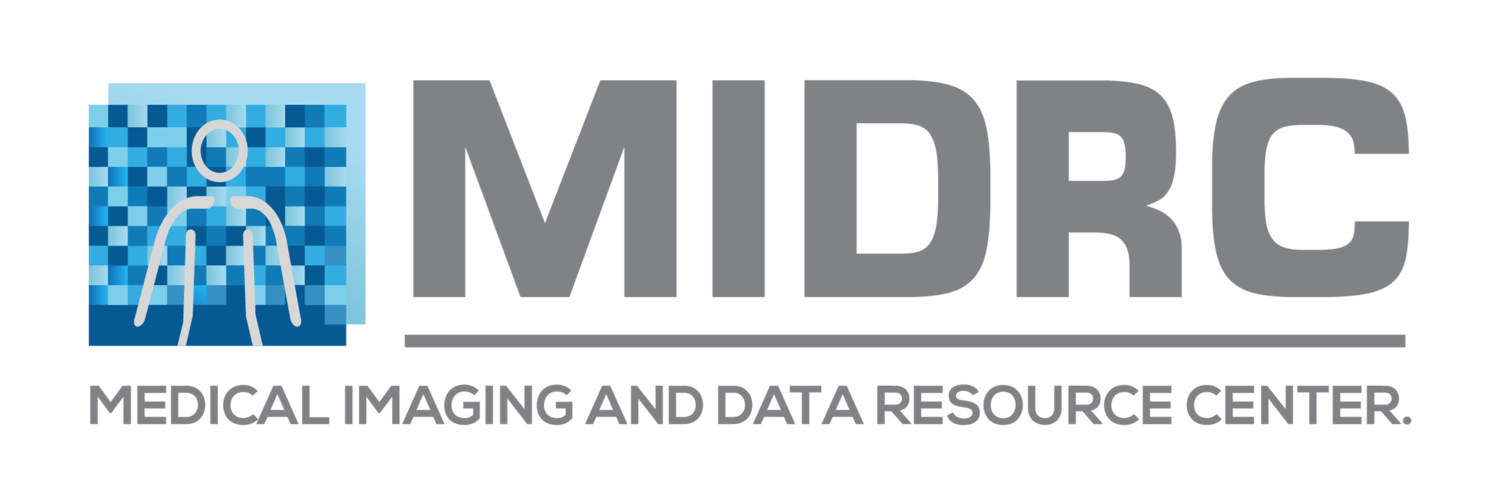Last updated September 2, 2025
Goals.
MIDRC’s primary mission centers on building and expanding a centralized, AI-ready data commons that drives innovation in machine intelligence for medical imaging research. By serving as a robust repository rooted in the FAIR principles (Findable, Accessible, Interoperable, and Re-usable), MIDRC provides high-quality, curated, and standardized imaging data while rigorously safeguarding patient privacy. The public entryway to MIDRC—the Data Commons Portal—is powered by the advanced Gen3 Data Ecosystem at the University of Chicago, offering access to medical images and metadata that support the creation of better algorithms and real-world healthcare solutions.
A key strength of MIDRC’s centralized data commons is its ability to bring together multi-source datasets, including contributions from both large academic medical centers and smaller clinical sites such as community hospitals. This broad participation supports more comprehensive and representative medical imaging research. Currently, MIDRC is expanding to include more image types, more anatomies, and different disease types with a focus on cancer. In parallel, MIDRC is actively working on strategies to improve interoperability with other non-imaging data commons. These efforts aim to enable researchers to connect imaging data and accompanying metadata in MIDRC with broader electronic health record data housed in external repositories, ultimately facilitating richer and more integrated analyses as these capabilities develop.
To further empower researchers, MIDRC has recently launched the Biomedical Data Fabric Imaging Hub (BIH), a federated data infrastructure created to enable seamless search, discovery, and analysis of imaging data across multiple medical imaging repositories. As part of the ARPA-H Biomedical Data Fabric (BDF), the Imaging Hub represents a major step toward scalable, integrated cohort building and cross-repository collaboration, supporting the next generation of biomedical imaging research.
The second goal of MIDRC is to advance the development of machine intelligence algorithms for disease detection, diagnosis, monitoring, and prognosis, with a strong emphasis on delivering practical tools and solutions for users. The organizational structure of MIDRC balances research and governance, ensuring that its initiatives not only drive scientific discovery but also support responsible development and deployment of resources. Within MIDRC, Technology Development Projects focus on building robust infrastructure, while Collaborating Research Projects conduct studies and provide recommendations on best practices. The committees and working groups ensure efficient communication and collaboration. These governance frameworks bring together expert teams committed to making their tools, algorithms, and resources—such as those available on the MIDRC GitHub—accessible to end users. In addition, MIDRC organizes scientific challenges that benefit the broader research community and ultimately enhance clinical practice and patient care.
The third goal is to help medical imaging investigators meet the new 2023 NIH Data Management and Sharing Policy. This NIH policy is intended to promote research discovery, rigor, and reproducibility through improving the FAIRness (Findable, Accessible, Interoperable, and Re-usable) of data. As a high-quality medical imaging data repository, MIDRC is here to help fulfill this new requirement.
Recent Accolades.
In January 2024, the U.S. National Science Foundation and collaborating agencies launched the National Artificial Intelligence Research Resource (NAIRR) pilot, a first step towards realizing the vision for a shared research infrastructure that will strengthen and democratize access to critical resources necessary to power responsible AI discovery and innovation. This pilot will enable AI research requiring privacy and security-preserving resources and will assemble privacy preserving resources. MIDRC has been selected to participate in this pilot project.
MIDRC was selected in September 2023 as one of several performers for the ARPA-H Biomedical Data Fabric (BDF) Toolbox. The ARPA-H BDF is an initiative to de-risk technologies for an easily deployable, multi-modal, multi-scale, connected data ecosystem for biomedical data. MIDRC will provide domain expertise and data commons technology development in medical imaging.
Creation of MIDRC is being accomplished through Technology Development Projects that build upon the collaborations across ACR, RSNA, and AAPM. In addition, MIDRC supports synergistic Collaborating Research Projects involving multiple academic institutions across the United States, all operating under principles of open science.
Questions? Check out our answers to frequently asked questions!
How to acknowledge 1) MIDRC funded research and 2) use of data downloaded from the MIDRC Data Commons










